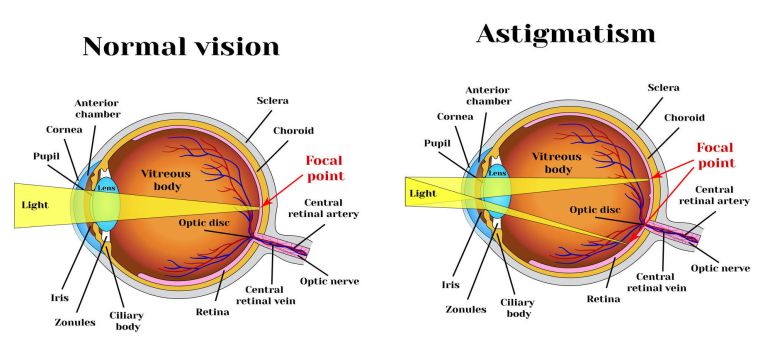
Do you struggle with blurry or distorted vision? Do you often squint to see clearly? You might have astigmatism—a common but treatable condition affecting millions worldwide. Unlike eye diseases such as glaucoma, astigmatism is simply a refractive error caused by an irregularly shaped cornea or lens.
The good news? It can be easily managed with the right corrective measures and lifestyle habits.
Astigmatism can cause a range of vision problems, including:
? Blurred or distorted vision at all distances
? Eye strain and discomfort
? Frequent headaches
? Difficulty reading small print
? Trouble seeing clearly in low light
? Squinting to focus
If you notice these symptoms, an eye exam can confirm whether astigmatism is the cause.
In a perfectly shaped eye, light focuses on a single point on the retina, creating a sharp image. In astigmatism, the cornea or lens is irregularly shaped, causing light to scatter across multiple points instead. This results in blurry or distorted vision.
Genetics – Often inherited and present from birth
Eye injuries – Trauma or scarring can alter corneal shape
Keratoconus – A condition where the cornea thins and bulges outward
Poor eye muscle development – Can lead to uneven focusing
Direct eye impact – Accidents or whiplash injuries
For mild cases, no treatment may be necessary. However, if your vision is significantly affected, here are the best ways to correct it:
Wearing corrective lenses is the simplest way to manage astigmatism.
Eyeglasses – Provide sharp vision by compensating for irregular corneal shape
Toric Contact Lenses – Specially designed to correct astigmatism
Since astigmatism can change over time, routine check-ups ensure your prescription stays up to date. Early detection also prevents symptoms like headaches and eye strain from worsening.
Procedures like LASIK and PRK reshape the cornea, providing a long-term solution for astigmatism. Consult an eye specialist to see if you’re a candidate.
Good eye health can help prevent strain and discomfort:
? Eat a nutrient-rich diet with vitamins A, C, and E for eye support
? Take regular breaks from screens to reduce eye fatigue
? Use blue light filters on devices to minimize strain
? Wear sunglasses to protect against harmful UV rays
Astigmatism is common, but it doesn’t have to impact your quality of life. With proper eye care, corrective lenses, and professional guidance, you can enjoy clear, comfortable vision every day. If you’re experiencing symptoms, book an eye exam to find the best solution for you
Don’t ignore blurry or strained vision—taking small steps today can make a big difference in your eye health. Whether it’s upgrading your prescription, making lifestyle adjustments, or exploring long-term solutions like laser surgery, there’s a way to improve your sight.
If you’re unsure where to start, schedule an appointment with an eye care specialist to discuss the best options for you. Clear vision is just a step away.